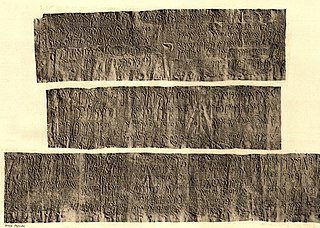
Charles-Jean-Melchior, Marquis de Vogüé was a French archaeologist, diplomat, and member of the Académie française in seat 18.

Jean Antoine Letronne was a French archaeologist.

Jean Emile Humbert was a Dutch lieutenant-colonel who can be credited with rediscovering ancient Carthage. As an agent for the Dutch government he procured vital parts of the collection of the National Museum of Antiquities in Leiden. Humbert was awarded the Order of the Netherlands Lion for his archaeological work.

The Punic-Libyan bilingual inscriptions are two important ancient bilingual inscriptions dated to the 2nd century BC.

The Assyrian lion weights are a group of bronze statues of lions, discovered in archaeological excavations in or adjacent to ancient Assyria.
Naïdé Ferchiou was a Tunisian archaeologist whose work dealt mainly with Roman North Africa. She excavated at several important sites, including Abthugni.

The Corpus Inscriptionum Semiticarum is a collection of ancient inscriptions in Semitic languages produced since the end of 2nd millennium BC until the rise of Islam. It was published in Latin. In a note recovered after his death, Ernest Renan stated that: "Of all I have done, it is the Corpus I like the most."

The Yehawmilk stele, de Clercq stele, or Byblos stele, also known as KAI 10 and CIS I 1, is a Phoenician inscription from c.450 BC found in Byblos at the end of Ernest Renan's Mission de Phénicie. Yehawmilk, king of Byblos, dedicated the stele to the city’s protective goddess Ba'alat Gebal.

The Marseille Tariff is a Punic language inscription from the third century BCE, found on two fragments of a stone in June 1845 at Marseille in Southern France. It is thought to have originally come from the temple of Baal-Saphon in Carthage. It is one of the earliest published inscriptions written in the Phoenician alphabet, and one of the longest ever found.

The Maktar and Mididi inscriptions are a number of Punic language inscriptions, found in the 1890s at Maktar and Mididi, Tunisia. A number of the most notable inscriptions have been collected in Kanaanäische und Aramäische Inschriften, and are known as are known as KAI 145-158.

The Bourgade inscriptions are approximately 40 neo-Punic inscriptions, found in the 1840s and early 1850s in Husainid Tunisia, which had just been opened up to French influence following the 1846 meeting between Ahmad I ibn Mustafa and Antoine, Duke of Montpensier.
Carthaginian tombstones are Punic language-inscribed tombstones excavated from the city of Carthage over the last 200 years. The first such discoveries were published by Jean Emile Humbert in 1817, Hendrik Arent Hamaker in 1828 and Christian Tuxen Falbe in 1833.

The Punic Tabella Defixionis is a 7th or 6th century Punic language curse tablet, inscribed on a lead scroll, found in Carthage by Paul Gauckler in 1899. It is currently held at the Carthage National Museum. It is known as KAI 89.

The Cirta steles are almost 1,000 Punic funerary and votive steles found in Cirta in a cemetery located on a hill immediately south of the Salah Bey Viaduct.

The Anat Athena bilingual is a late fourth century BCE bilingual Greek-Phoenician inscription on a rock-cut stone found in the outskirts of the village of Larnakas tis Lapithou, Cyprus. It was discovered just above the village, at the foot of a conical agger, 6m high and 40 meters in circumference. It was originally found in c.1850.

The Pricot de Sainte-Marie steles are more than 2,000 Punic funerary steles found in Carthage near the ancient forum by French diplomat Jean-Baptiste Evariste Charles Pricot de Sainte-Marie in the 1870s. The find was dramatic both in the scale—the largest single discovery of Canaanite and Aramaic inscriptions—and also due to the finds almost being lost in the sinking of the French ironclad Magenta at Toulon.

The Ain Nechma inscriptions, also known as the Guelma inscriptions are a number of Punic language inscriptions, first found in 1837 in the necropolis of Ain Nechma, in the Guelma Province of Algeria.

The Persephone Punic stele is a marble bas-relief stele of the Greek deity Persephone above a short punic inscription.

The Carthage tophet, is an ancient sacred area dedicated to the Phoenician deities Tanit and Baal, located in the Carthaginian district of Salammbô, Tunisia, near the Punic ports. This tophet, a "hybrid of sanctuary and necropolis", contains a large number of children's tombs which, according to some interpretations, were sacrificed or buried here after their untimely death. The area is part of the Carthage archaeological site, a UNESCO World Heritage site.

The Falbe Punic inscriptions are three Punic inscriptions, found in Carthage by Christian Tuxen Falbe in 1833 in Husainid Tunisia.



















